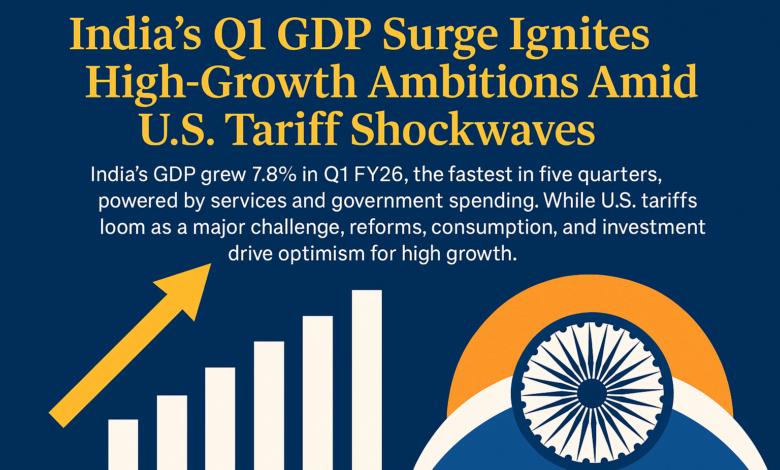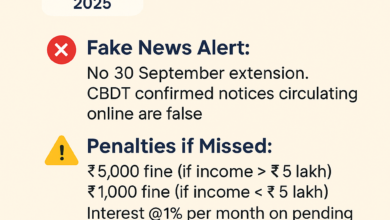India’s Q1 GDP Surge Ignites High-Growth Ambitions Amid U.S. Tariff Shockwaves

India has roared back to one of its strongest economic performances in recent memory, with GDP growing by an impressive 7.8% year-on-year in the April–June quarter of FY26—its fastest pace in five quarters and significantly above expectations. Reports from the NSO confirm this acceleration beat forecasts by a wide margin, outperforming both the RBI’s projection and market estimates.
This surge underscores the resilience of India’s growth engine, supported by strong consumption, elevated government spending, and robust activity across the services, manufacturing, and construction sectors.
Yet, this robust momentum arrives against a backdrop of escalating global friction—especially the U.S. doubling tariffs on Indian goods to 50%, posing a looming threat to export dynamics and the broader economic outlook. Engine of Growth: What Fuelled Q1’s Surprise Outperformance?
Let’s unpack what powered this first-quarter breakout:
-
Services Sector Activity at Full Throttle
The tertiary sector delivered a standout performance, growing at over 9%—a two-year high propelled by gains across trade, hospitality, finance, real estate, and professional services. -
Manufacturing and Construction Rebound
Manufacturing rose 7.7%, while construction gained 7.6%, cementing the recovery and buoying secondary sector activity. -
Agriculture’s Steady Role
Although modest at 3.7%, agriculture contributed meaningfully to the broader GDP uplift. -
Strong Government Spending
Government consumption soared nearly 7.4%, complemented by front‑loaded capital expenditure—both decisive contributors to Q1’s impressive growth. -
Private Consumption and Investment Sustained
Private consumption held firm at 7%, aided by rural demand and tax relief measures, while investment also held steady. -
Front‑Loaded Exports Cushion the Drag
A flurry of shipments to the U.S. ahead of the tariff implementation created a temporary export boost—though experts caution this is unlikely to persist.
Obstacles Ahead: U.S. Tariffs Cast a Looming Shadow
The stimulus of Q1 may be fleeting as U.S. tariffs raise stakes significantly:
-
Tariffs Hit Key Export Segments
Industries like textiles, leather, and chemicals—accounting for a notable share of India’s exports—face stiff headwinds from the 50% levy. -
Macro Forecasts Trimmed
Economists warn the tariffs could shave off 0.6 to 0.8 percentage points from India’s aggregate GDP growth. -
Currency and Bond Market Volatility
The rupee plummeted to record lows (below 88 to a dollar), while bond yields spiked amid uncertainty over export viability. -
Temporary Nature of Export Spikes
Experts—such as those from Bloomberg and DBS—point out that the export boost was largely front‑loaded and unlikely to repeat in future quarters.
Turning Threat into Opportunity: Reforms Rise Center Stage
India is responding with renewed vigor:
-
GST Rationalization on the Table
The government is pushing for GST rate cuts, anticipated to take effect ahead of the festive season—aiming to spur consumption and provide tax relief. -
Reform-Commissions Established
Two high-powered regulatory commissions—chaired by Prime Minister’s principal secretary and the cabinet secretary—are charting a roadmap for structural reform. -
Sovereign Ratings Maintain Confidence
Fitch reaffirmed India’s ‘BBB‑’ rating with a stable outlook, citing strong growth prospects and external buffers, despite identifying tariffs as a medium-term risk. -
Revisions for Consumption and Nominal Growth
SBI Research suggests that GST and tax reforms could boost nominal GDP by as much as 1.6%, or ₹5.31 lakh crore—offsetting tariff-induced pressures.
The Road Ahead: Can India Sustain Its High-Growth Drive?
Despite the immediate uncertainties, India’s economic narrative remains upbeat:
-
Momentum Remains Buoyant—At Least Temporarily
The Q1 surge reflects resilience across the economy—particularly in services and public spending—creating optimism for a strong FY26. -
Forecasts Nudged Toward 6.5–6.8%
Official projections from the CEA and RBI indicate a full-year growth band of 6.3%–6.8%, with some analysts holding to 6.5%—assuming robust domestic demand and policy support. -
Sustained 8–9% Growth: A Long-Term Aspiration
Economists like Dr C Rangarajan and Rishikesha Krishnan advocate for persistent high growth—above 8–9% annually over the next two decades—as critical for India to join the ranks of advanced economies. -
Beyond Tariffs: Reforms as the Differentiator
Analysts caution that while tariffs are a near-term challenge, the real test lies in how effectively India implements reforms, rationalizes taxes, and mobilizes private investment.
In Summary
India’s 7.8% GDP surge in Q1 of FY26 is not just a statistical high—it’s a statement of economic resilience amid rising global trade tensions. While U.S. tariffs pose real risks to exports and growth, domestic strength—powered by services, consumption, government expenditure, and sweeping reforms—offers a counterbalance.
The challenge now is to convert this moment of promise into sustained long-term growth. That requires not just policy measures but structural changes that unlock innovation, investment, and productivity gains.
If India can sustain reform momentum, this may well be its “1991 moment”—a turning point toward high-growth, transformation, and rising global stature.


